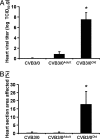An aged host promotes the evolution of avirulent coxsackievirus into a virulent strain
- PMID: 16950876
- PMCID: PMC1564236
- DOI: 10.1073/pnas.0605507103
An aged host promotes the evolution of avirulent coxsackievirus into a virulent strain
Abstract
The emergence of new, more pathogenic viruses necessitates elucidation of factors that promote viral evolution. Aging, a potential factor, is associated with increased susceptibility to viral infections. We used the enterovirus coxsackievirus B3 (CVB3) to investigate the effects of host age on pathogenicity and viral gene sequence. Old mice infected with a normally amyocarditic strain of CVB3, CVB3/0, had significantly higher mean heart viral titers compared with CVB3/0-infected adult mice. To determine whether a change in the CVB3/0 viral population could contribute to the higher titers observed in the old infected mice, CVB3/0 was passed once through an old or adult host and the changes in pathogenicity and viral genome were examined after subsequent infection of old or adult mice. Adult mice infected with CVB3/0 that was passed through an old host (CVB3/0(Old)) exhibited significantly higher heart viral titers, pathology, and weight loss than adult mice infected with either stock CVB3/0 or CVB3/0 passed through an adult host (CVB3/0(Adult)). Sequence analysis of virus isolated from CVB3/0(Old)-infected mice revealed 13 specific and reproducible nucleotide changes. These changes result in a sequence that matches the virulent CVB3/20 strain and are associated with promoting cardiovirulence. In contrast, we observed only one nucleotide change, low heart viral titers, and no heart and liver pathology in adult mice infected with CVB3/0(Adult). These results demonstrate that the aged host promotes rapid selection of a pathogenic variant of CVB3 from an avirulent strain and introduces a host-virus paradigm for studies of viral infection in the aged.
Conflict of interest statement
Conflict of interest statement: No conflicts declared.
Figures



Similar articles
-
Copper deficiency increases the virulence of amyocarditic and myocarditic strains of coxsackievirus B3 in mice.J Nutr. 2008 May;138(5):849-55. doi: 10.1093/jn/138.5.849. J Nutr. 2008. PMID: 18424590
-
Secondary heterotypic versus homotypic infection by Coxsackie B group viruses: impact on early and late histopathological lesions and virus genome prominence.Cardiovasc Pathol. 1999 Mar-Apr;8(2):93-102. doi: 10.1016/s1054-8807(98)00025-8. Cardiovasc Pathol. 1999. PMID: 10724506
-
Genomic determinants of cardiovirulence in coxsackievirus B3 clinical isolates: localization to the 5' nontranslated region.J Virol. 2000 May;74(10):4787-94. doi: 10.1128/jvi.74.10.4787-4794.2000. J Virol. 2000. PMID: 10775617 Free PMC article.
-
A Kidnapping Story: How Coxsackievirus B3 and Its Host Cell Interact.Cell Physiol Biochem. 2019;53(1):121-140. doi: 10.33594/000000125. Cell Physiol Biochem. 2019. PMID: 31230428 Review.
-
Mechanisms and consequences of enterovirus persistence in cardiac myocytes and cells of the immune system.Virus Res. 1999 Aug;62(2):149-58. doi: 10.1016/s0168-1702(99)00041-6. Virus Res. 1999. PMID: 10507324 Review.
Cited by
-
Caspase-3 inhibitor inhibits enterovirus D68 production.J Microbiol. 2020 Sep;58(9):812-820. doi: 10.1007/s12275-020-0241-y. Epub 2020 Sep 1. J Microbiol. 2020. PMID: 32870487 Free PMC article.
-
Does a younger host make the virus weaker? Presenting a new hypothesis.Diabetes Metab Syndr. 2020 Nov-Dec;14(6):1821-1822. doi: 10.1016/j.dsx.2020.09.011. Epub 2020 Sep 13. Diabetes Metab Syndr. 2020. PMID: 32956927 Free PMC article.
-
Identification of a nucleotide in 5' untranslated region contributing to virus replication and virulence of Coxsackievirus A16.Sci Rep. 2016 Feb 10;6:20839. doi: 10.1038/srep20839. Sci Rep. 2016. PMID: 26861413 Free PMC article.
-
Micronutrient status, immune response and infectious disease in elderly of less developed countries.Sight Life Mag. 2009;3:6-15. Sight Life Mag. 2009. PMID: 22540112 Free PMC article. No abstract available.
-
Rheum emodin inhibits enterovirus 71 viral replication and affects the host cell cycle environment.Acta Pharmacol Sin. 2017 Mar;38(3):392-401. doi: 10.1038/aps.2016.110. Epub 2016 Nov 14. Acta Pharmacol Sin. 2017. PMID: 27840410 Free PMC article.
References
-
- Yoshikawa TT. Clin Infect Dis. 2000;30:931–933. - PubMed
-
- Hayek MG, Taylor SF, Bender BS, Han SN, Meydani M, Smith DE, Eghtesada S, Meydani SN. J Infect Dis. 1997;176:273–276. - PubMed
-
- Schmader K. Clin Infect Dis. 2001;32:1481–1486. - PubMed
-
- Pinner RW, Teutsch SM, Simonsen L, Klug LA, Graber JM, Clarke MJ, Berkelman RL. J Am Med Assoc. 1996;275:189–193. - PubMed
Publication types
MeSH terms
Grants and funding
LinkOut - more resources
Full Text Sources
Other Literature Sources
Medical

